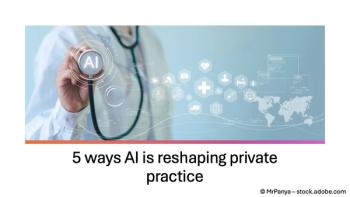
Lessons Learned: ‘My EMR Nightmare … And Why I’d Do it Again’
Think you have IT problems? You ain’t heard nothin’ yet.
It was a typical gray Seattle day in fall 1996. Earlier in the year I had launched my first solo family-medicine practice, and I was operating two offices - a rural clinic in Maple Valley, Wash., and my main office in Bellevue, 30 miles away.
I was attending a CME event sponsored by my local medical association during which software vendors were invited to demonstrate their latest EMR products. As I watched one local vendor effortlessly glide a mouse-driven cursor across a large overhead screen portraying an electronic medical record desktop, I could easily visualize my own medical desk in electronic form. The system’s capabilities were impressive. It could record patient labs, medical histories, and medications. I could print out prescriptions, record insurance demographics, generate patient reminders, review practice protocols, and benefit from other common EMR features. By the end of that afternoon, I was convinced that EMRs were the wave of the future, and I wanted to be there for the ride.
I looked upon acquiring an EMR as a solution to the never-ending frustration of missing charts, missed dictations, and misfiled chart notes. Since I was new to the technology, one of the most important factors in my purchasing decision was that the system I bought be sold and serviced by a local company within close proximity to my office. I assumed such a company could more easily provide access to training and back-up services. I was an easy sale.
I accordingly chose a local vendor, and it negotiated a system design that it said would best suit my needs.
“Will the system accommodate the uniqueness of my practice - an osteopathic family practice - serving two locations?” I asked.
“No problem,” replied the salesperson. “The two clinics will talk to each other over a telephone line so that charts can be accessed from either location.” The server would be located at the Bellevue office, and I was told it would coordinate all electronic data to workstations at both locations.
The final price was an eye-popping $45,000. Arranging financing was amazingly easy. I signed a one-page lease agreement filled with fine print, and within a few days everything was a go.
Over the next two weeks, the vendor’s installation technicians were in my Bellevue office measuring, wiring, installing workstations, and setting up the servers - as in plural. I was now told that two servers were going to serve two systems - my newly purchased EMR and the practice management system I bought from the same vendor.
I expressed surprise at this two-server approach, and I was told: “Oh, no problem, they talk to one another through a practice management system (PMS) link. That way the electronic medical records pass information to the PMS, and billings can then be generated directly from patient encounters.” That sounded logical to me. Within two weeks the system was installed, the training was underway, and everything seemed on track.
Opening day
April 1997 brought our first day of operation with our new EMR and real patients. Right out of the gate, our patient charts (containing demographics, medical histories, and the chief complaints entered by the front desk) that were to be sent to specific exam rooms didn’t arrive. Some made it after several hours; others never showed up.
My vendor discovered that my practice management system and my EMR used different operating platforms that apparently were not on speaking terms. Each system worked fine separately, but they weren’t working well together.
“Has this system design ever been tested elsewhere?” I asked the vendor salesman, who sheepishly admitted: “Uh … no … but there is no reason why it shouldn’t work. We think we can work out the details if you just give us some more time.”
But there was no more time. This electronic engineering nightmare was now turning into a research and development project with my solo practice as the guinea pig.
My Maple Valley site was suffering. With the EMR server 30 miles away, its computers were receiving data in slow motion. I was then told that the telephone lines were at fault. “If we install a special ISDN line capable of carrying more data faster, then the problem would be resolved,” said the vendor. Of course, that meant forking over another $10,000 to pay for the new phone lines and the special routers they required. It was now August, and we’d been hobbling along with our defunct EMR for four months.
Ten grand and a month later, the data transfer to our Maple Valley site was a tiny bit faster, but still not fast enough. A T1 line was then suggested. But when we investigated, we discovered those lines were not yet available in rural Maple Valley. So in a moment of desperation, I came up with my own fail-safe solution. In September, I began transporting the server between the two offices myself.
After my vendor expressed his horror at my proposed solution, I admit that I was intimidated by the prospect. But what else could I do? I recall what was to be the first of my many server transport trips quite well. When disconnecting the server, I meticulously labeled each of the wires I removed and matched them with numbers I’d placed on each of the server’s many ports. I then wrapped the disconnected server in blankets and carried it to my car like a fragile infant. I buckled it in the front seat beside me and worried during the entire trip that it would take a tumble and my significant investment would break into pieces.
When I arrived at Maple Valley, I reversed the process, and to my surprise, my “baby” sprang to life! In time, I refined my means of transportation by using a padded, low-wheeled luggage cart.
By using the same server at both locations, I finally conquered the slow data transmission problem, and I now had a functional EMR at both offices. I continued my personal server transport solution for more than two years before I finally elected to close my Bellevue office and consolidate my operations at Maple Valley. It was December 2001 - nearly four years after implementing the EMR. I finally abandoned my original EMR purchase and switched to a new one in January 2002.
With the centralization of my practice into a single location, a new server was designed and installed with considerably increased capacity. Today my still-solo practice continues to operate smoothly with a single robust server and five workstations in Maple Valley.
But wait, there’s more…
While I continued to struggle to manage the demands of a busy solo practice, in addition to the financial problems created by a poorly designed and dysfunctional system, I decided it wasn’t right to continue to pay for equipment that was defunct from the start. So I demanded my money back. That didn’t happen. So in August 2000, I sued. I sued everyone - including the leasing company. That turned out to be a bad idea.
As the lawsuit unfolded, it turned out that the leasing company was the main fly in the legal ointment. It considered itself “at no fault” and started its own recovery action for the money it deemed still owing on the original lease. Even though all the defunct equipment had been returned (transported via my own pick-up truck and deposited in the leasing company’s parking lot), the company demanded full payment for the entire length of the lease. It claimed more than $80,000 still owing for a system that initially cost me $45,000 (and was probably worth less than $10,000). Interim payments had already been made to the company for a system that never worked to the tune of approximately $40,000. Plus, it was asking for legal and collection costs, which amounted to another $10,000.
After obtaining some legal advice, in April 2002, I decided to settle rather than fight this seemingly unending and complex legal battle for $50,000. So the total cost of my defunct system included $45,000 for the initial equipment purchase and design costs, an additional $10,000 to supposedly make my remote office functional, plus approximately $40,000 in payments I made to the leasing company. Then I had to replace all of my original equipment using my own designers and resources. And now I had to pay the leasing company another $50,000 to go away.
My good faith and ignorance about this industry ended up costing me in excess of $100,000, and I had basically nothing to show for it. What survived was a single operating platform of my own design utilizing my now-functional EMR software and a separate stand-alone practice management system of a very simple variety that I purchased for $1,000. Each system functions separately with its own server, although they share the same workstation monitors and keyboards using hand-operated switches.
Did my decision to convert to electronic medical records represent a cost saving to my practice? Definitely not. Would I go back to paper charts again? Definitely not.
Here’s why.
What I like about my EMR
1. Charts never get lost. Patient charts can easily get separated for different types of office encounters. Sometimes patients are involved in motor vehicle accidents while they have an active worker’s compensation claim in process. Now, requests for chart notes from third-party payers can easily be kept separate by establishing separate charts for each patient for different purposes. It’s wonderful to be able to field inquiries regarding a patient encounter and never have to search the clinic for elusive charts.
2. Electronic medical records are complete and comprehensive. Patients’ histories, allergies, medications, and all aspects of their encounters are now nicely organized and easily located. With a single mouse click, we can print chart summaries of the principle patient information we need.
Our EMR turned out to be a savior when our practice underwent an audit from a major insurance payer in 2001. It accused our practice of “upcoding” and fraudulent billing following an audit in which it refused to recognize the -25 modifier when osteopathic manipulation was coupled with an E&M service. Despite the fact that the use of this modifier was perfectly legal, recognized by Medicare and by our own medical association guidelines, the payer demanded we return tens of thousands of dollars already paid on patient accounts, and they threatened my practice with criminal charges if we didn’t comply.
In the end, we were charged with no criminal wrongdoing. In my opinion, we were saved from this fate by our EMR, which enabled me to quickly produce comprehensive justifications for each claim we submitted. Once the payer’s attorneys received our electronically generated comprehensive patient medical records, they quickly became less aggressive.
3. Electronic patient records are secure. Once we close the electronic chart note for each patient and file them at the end of the day, those records are cast in electronic stone and cannot be altered. No other office person or assistant besides me is authorized to close patients’ charts, thereby providing excellent security and integrity of individual records.
4. EMRs enable more accurate coding. In 2001, our EMR added an E&M calculator to its system, which has served as a very useful function in documenting E&M levels for billing purposes. Once a patient chart note is complete, the visit’s specific E&M level and CPT code amount are automatically tabulated - in accordance with industry guidelines - and listed at the end of the chart encounter. We no longer guess at E&M codes, and our use of the calculator has significantly increased our income. Without it, we were often mistakenly undercoding patient encounters.
5. We can now accurately track patient medications. EMRs have an unequalled pill-counting ability with an insatiable memory. Our system easily identifies problems with early refills for chronic pain patients, and they are brought to my attention. I cannot imagine a chronic pain management practice without an EMR to track pills and refill dates.
6. We can accurately track potential medication interactions. Our system not only covers prescription medications, but also food allergies, herbal remedies, and over-the-counter drugs. No more embarrassing calls from pharmacists pointing out important interactions after I write prescriptions.
7. Patients like my “photographic memory.” Our EMR incorporates a reminder system in which we can embed pop-up messages during patient encounters. Those reminders may pertain to specific follow-up vaccinations or other procedures, or they may be as simple as information about a specific patient’s family or personal situation. When I comment on these items during a follow-up visit - frequently months later - patients are astonished by my photographic memory.
8. My handwriting is now legible to all. Printed prescriptions mean no more snide remarks from pharmacists about illegible handwriting. All prescriptions are neatly printed. I then add an embossed seal to the prescription, making it difficult to duplicate.
9. Real-time charting within exam rooms mean reimbursement for all of my time. Before my EMR, I would see as many patients as possible during the day, often hand-writing notes, falling behind, and setting aside charts to be dictated later. When I sat down after clinic hours to complete patient charting, I robbed myself and my family of valuable time and energy by instead performing unreimbursed work. If properly designed, EMRs force doctors to do their charting in real-time with the patient present in the exam room. This results in a real financial benefit to the bottom line - and more free time.
10. Tracking lab results and trends is easy. Once a patient’s lab data is entered into our EMR, it can represent the findings in different formats. For example, cholesterol levels can be monitored in easily readable graphs. Growth and development charts for pediatric patients can be charted so parents can easily visualize and follow their child’s progress. Printed copies of such patient information, handed to patients as they leave the exam room, are very popular.
11. Patient education handouts increase satisfaction. Our EMR contains a considerable database of useful patient education materials on a wide variety of medical topics that they can take home with them. And patients love them.
12. Interoffice communication is easier than ever. Our EMR enables easy electronic communication among office staff. Telephone calls, prescription refill requests, patient reminders, action items, and other information are now easily passed back and forth between desktops, eliminating the need for a telephone intercom system.
13. We can easily fulfill chart note requests. The former unending chore of copying chart notes to submit to motor vehicle accident and work-related injury third-party payers is now much easier. Many practices hire outside vendors to come into their offices and photocopy patient charts for this purpose. Now we can produce these charts with a simple mouse click. Another time-consuming administrative job eliminated!
14. Referral letters are a breeze. One mouse click pulls a name from a database of referral healthcare providers, prints a referral letter after I enter my specific request, tailors it to the patient I’m treating, and the system does the rest for me. I can give the letter to my patient at the end of the encounter and/or directly send it by fax or e-mail to the referral physician’s office. By the time the patient has left the building, the referral physician’s staff has already been alerted and is prepared for the patient’s call for an appointment.
15. You can access many additional expandable features. Our EMR incorporates many analytical functions we don’t use that may be helpful for larger practices. Upgrades for our system are produced on a regular basis, and they can be downloaded electronically after office hours.
16. Complying with HIPAA regulations is much easier. Any paper records used in the process of the patient encounter (such as referral letters or reports from other doctors) can be scanned into patient charts and then shredded.
17. At the end of the day, we’re done! When patient charts are completed and filed electronically, they’re physically gone. They are stored indefinitely on a small magnetic tape that is automatically backed up at the end of each day on the server. Our shelves and cabinets that formerly housed volumes of paper charts and boxes (not to mention the stacks of charts on various desks), are now available for other uses. Workspaces are now impressively clear at the end of each day.
What I don’t like about my EMR
Actually, very little:
1. Getting over the learning curve. Plan on the better part of a year to become fluent with your EMR system, particularly if it’s especially complex. If staff or physician keyboarding skills are lacking, providing a typing or keyboarding course prior to embarking on your implementation process can be invaluable. Build excitement among your staff by encouraging them to look upon your EMR transition as an exciting new way to improve their knowledge and skills in managing patient care.
My own learning curve was obviously quite costly. To avoid my mistakes, choose a fully integrated EMR and practice management system that work on the same operating platform; avoid using leasing firms to purchase EMRs; hire an expert consultant with experience in implementing and operating an EMR system in a practice environment like yours; and choose a vendor that can best meet your needs rather than one that’s geographically handy. (In our case, our most vital technical assistance has been provided effectively and consistently by a vendor located on the other side of the continent.)
2. It’s difficult to identify EMRs that use the same operating platforms as your practice management system. Our experience with joining our EMR and PMS, which use different operating platforms, was fraught with technical difficulties. Do your homework to locate operating system-compatible software. Avoid electronically linking systems.
3. Costs can quickly mount up. Start-up costs can be high, particularly when you run into unforeseen technical glitches. Using a consultant with firsthand experience with EMR implementations can save you thousands of dollars down the line. Also, as technology advances, workstation costs are coming down compared to five to 10 years ago. It’s a good time to buy with plenty of high-capacity equipment now available at very competitive prices.
Dale Alsager, DO, PhD, FACOFP, operates his osteopathic solo family practice, the Country Doctor Clinic, in rural Maple Valley, Wash. He describes himself as “a hard-core osteopathic physician and surgeon who enjoys being the ‘Lone Ranger,’ and a fearless, unrelenting advocate for my patients in the face of disease or dilemma.” Dr. Alsager can be contacted via
This article originally appeared in the 2008/2009 Physicians Practice Technology Guide.
Newsletter
Optimize your practice with the Physicians Practice newsletter, offering management pearls, leadership tips, and business strategies tailored for practice administrators and physicians of any specialty.









